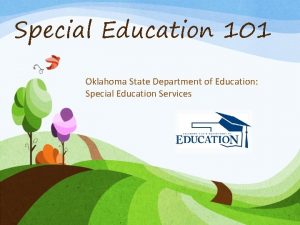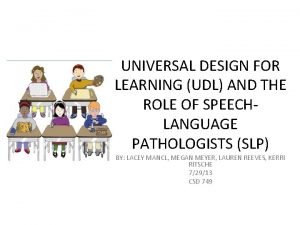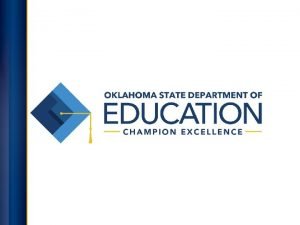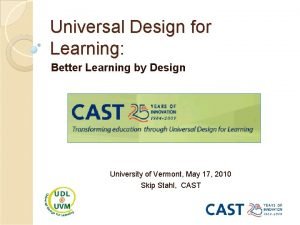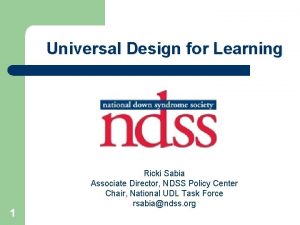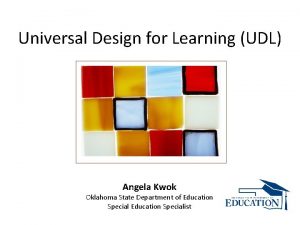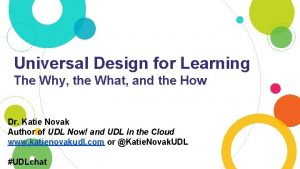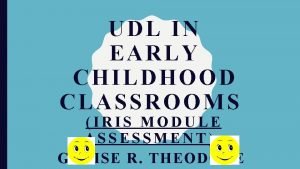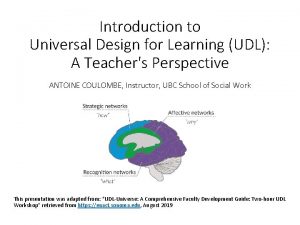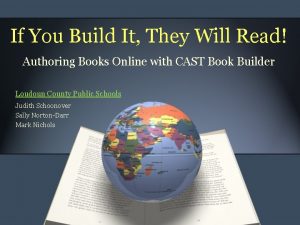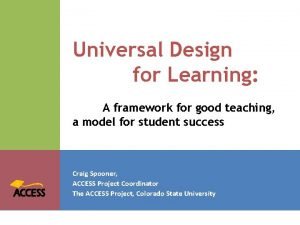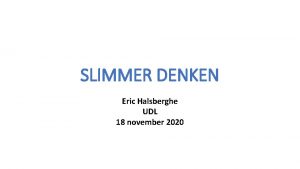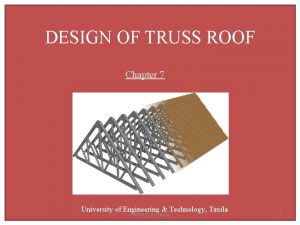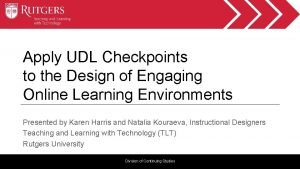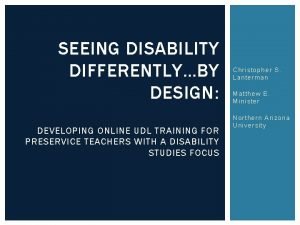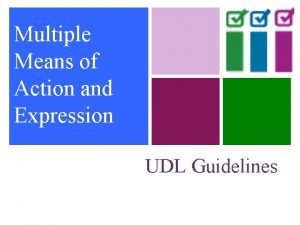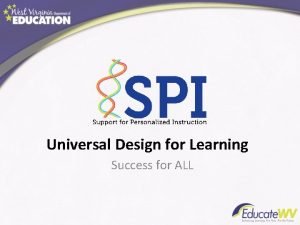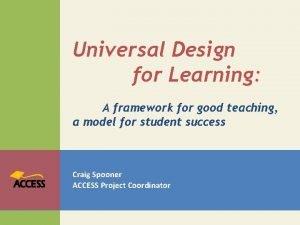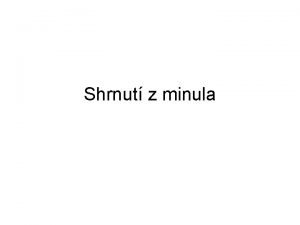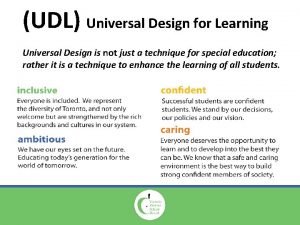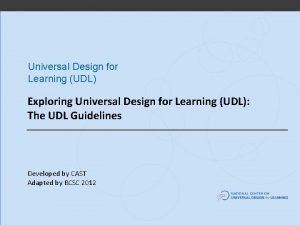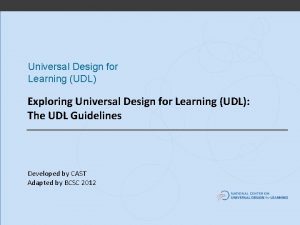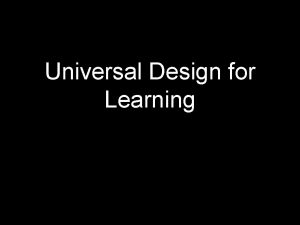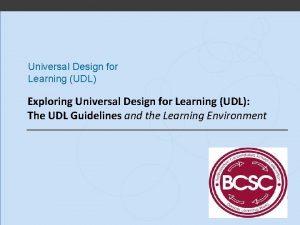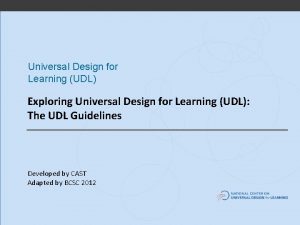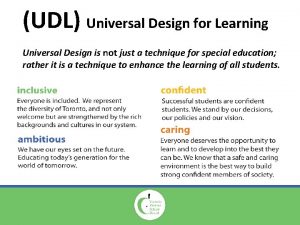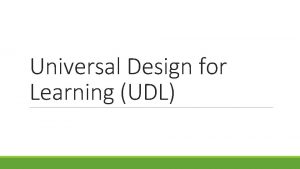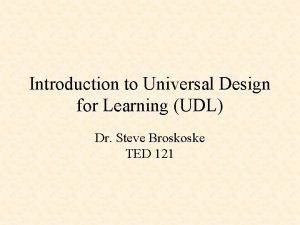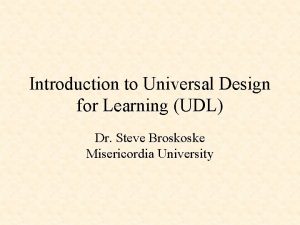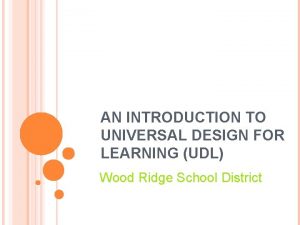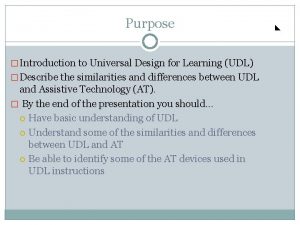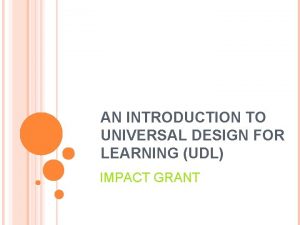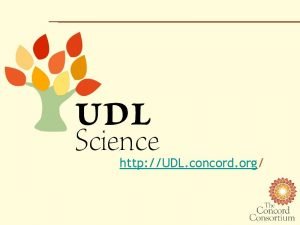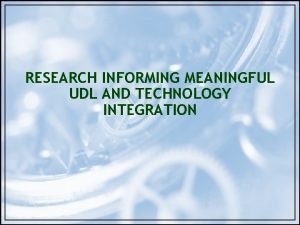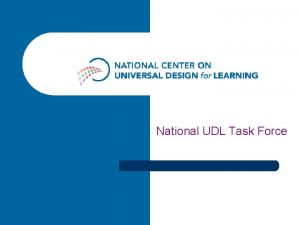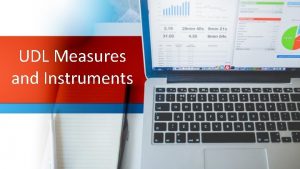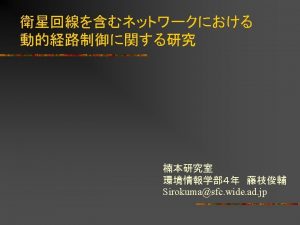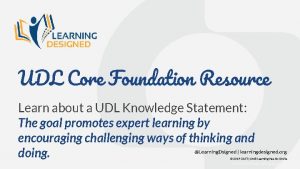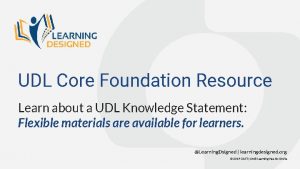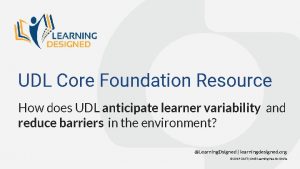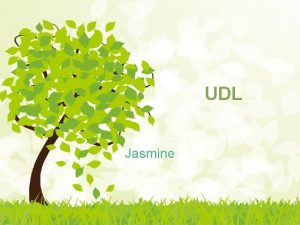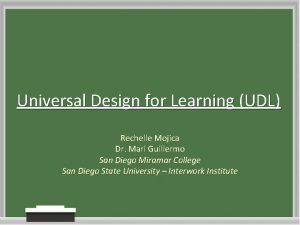Introduction to Universal Design for Learning UDL A




































- Slides: 36

Introduction to Universal Design for Learning (UDL): A Teacher's Perspective ANTOINE COULOMBE, Instructor, UBC School of Social Work This presentation was adapted from: “UDL-Universe: A Comprehensive Faculty Development Guide: Two-hour UDL Workshop” retrieved from https: //enact. sonoma. edu, August 2019

I would like to acknowledge that we are located on the traditional, ancestral, and unceded territory of the Musqueam people.

Agenda • What is UDL? Origins Guidelines How it Works • UDL Course design – An Example • Practice and Discussion

Learning Outcomes At the end of this UDL workshop, you will be able to: • Explain how the main theoretical elements of UDL can enhance accessible course design. • Apply the UDL framework in practical ways when reviewing your course design. • Situate UDL with other pedagogical frameworks and build synergies between methods.

About me: SW, Montreal, Diversity, Values, UDL, …

About diversity of students • Canadian Universities have experienced termendous growth since 1980 – enrollements expanded by 81% - to now 2 million students. • A significant portion of these enrolment gains come from a diverse group of students who’s participation in higher education was previously limited • Students with Indigenous background • Students with disabilities • First generation students (over 200 origins) • Etc. From: Cox, D. G. H. , Strange, C. C. , Scholars Portal Books: Canadian University Presses 2016, & des. Libris - Books. (2016). Serving diverse students in canadian higher education. London; Kingston; Chicago; Montréal; : Mc. Gill-Queen's University Press.

UDL and working with diversity Teachers often share similar concerns: • Teach everyone. • Be fair to everyone. • Help everyone feel included. • Etc. A challenge we encounter: the complexity of diversity. A question UDL asks: How to build inclusive education for all abilities?


Social Model of Disability It is the environment that reveals the disability; disability is not a condition in itself but a condition in a situation.

Social Model of Disability • In the classroom • Universally Disabling Presenttaion • Disabling presentation for some • « Normal » presentation (disabling without glasses) • Inclusive presentation


Universal Design Is our physical environment welcoming? Dis. Web © 2000 Karen G. Stone • Architectural term coined by R. Mace • Physical environment design for access • Stairs as access feature/barrier • Physical Disabilities • Elderly • Children • Strollers/Carts • Retrofitting for physical access remains a design afterthought

Origin: Universal Design (UD) Is our physical environment accessible? • Ronald Lawrence Mace, FAIA (1941 – June 29, 1998) was an American architect, product designer, educator, and consultant. He is best known for coining the term universal design and for his work advocating for people with disabilities. Instead of adding accessibility adaptations, the physical environment is immediately conceived as accessible, within the design of the building. (from Wikipedia). Want to know more: Podcast Exclusive “interview” with the late Ron Mace, father of universal design

Universal Design Solutions Blusson Spinal Cord Centre https: //icord. org/ourfacility/buildingaccessibility/ Universal Design: • Intentional approach to design • Anticipates a variety of needs • Broadens usability to public • More economical • Respects human diversity


Universal Design for Learning Is our pedagogical environment welcoming? UDL is the proactive design of our courses to ensure they are educationally accessible regardless of learning style, physical or sensory abilities. Just as physical barriers exist in our physical environment, curricular barriers exist in our instructional environment.

UDL at a Glance – cast. org https: //youtu. be/U 1 B 6 y. QXsr 0 c

UDL Guidelines

UDL Guidelines Structure

Multiple Means of Engagement Affective Networks The « WHY » of Learning Learners differ markedly in the ways in which they can be engaged or motivated to learn. § Recruiting Interest: Spark excitement and curiosity for learning. Barrier: Offer one choice. § Sustaining Effort & Persistence: Tackle challenges with focus and determination. Barrier: Complex task, lack of clarity. § Self Regulation: Harness the power of emotions and motivation in learning Barrier: No opportunities for self-reflection.

Multiple means of Representation The « WHAT » of learning Learners differ in the ways that they perceive and comprehend information that is presented to them. Perception: Interact with flexible content that doesn't depend on a single sense like sight, hearing, movement, or touch. Barrier: Only access to paper copies of texts. Language & Symbols: Communicate through languages that create a shared understanding. Barrier: Frequent use of “slang” and local knowledge. Comprehension: Construct meaning and generate new understandings. Barrier: Assume every student has the same academic knowledge.

Sample Graphic Organizers

Multiple means of Action & Expression The « HOW » of learning Learners differ in the ways that they can navigate a learning environment and express what they know. Physical Action: Interact with accessible materials and tools. Barrier: Only hand written exam. Expression & Communication: Compose and share ideas using tools that help attain learning goals. Barrier: Everyone will do a class presentation. Executive Functions: Develop and act on plans to make the most out of learning. Barrier: Complex task with no guidelines.

UDL process Establish Clear Learning Outcomes Use UDL to: Identify Barriers in Course Design Reflection and New Understanding Anticipate Learner Needs Identify “Big Ideas” that increase accessibility Representation Expression & Action Engagement Instructional Experience Measurable Outcomes and Assessment Plan

UDL : an umbrella

Benefits of UDL Practices • Enables you to reach a diverse student population without necessarily modifying your course requirements or academic expectations. • Provides you the tools to consider what and how you teach in a structured and systematic manner. • Increases student participation, achievement, and satisfaction.

UDL, Co. P and Montreal Research Project Montreal UDL Research Project More here: Projet CUA http: //pcua. ca/ Collaboration with 5 Higher Education Institutions (Ude. M, UQAM and 3 CEGEP) Community of Practice (Co. P) and Pilot Projects over a period of 2 years (2014 -2015).

Social Work with Groups (2014) By the end of this course, you will be able to apply : • Social Work with group theories in practice; • Roles and tasks of the group Social Workers; • Process of Implementing of a group: planning, implementation and evaluation. About the students - Very diverse: cultural backgrounds, age, learning styles and abilities, academic background. - Social Work with Groups is a challenge for most of them (stress of talking in front of a group, being a leader, etc. ).

Multiple Means of Representation Analysis of what is offered in the course: Diverse means of representation are offered in class Outside of class, learning relies heavily on one book and articles Goal: Diversify accessible options for Representation outside class Create a Course Blog with multiple accessible means of representation (e. g. videos, real examples of practice, case studies, stories, assignement models, maps, etc. ) Praxis et l’art du travail social: https: //praxistravailsocial. wordpress. com/

Multiple Means of Action and Expression Analysis of what is offered in Course experience: Main assignment offers multiple means of action and expression Two assignments could offer more options Goal: Diversify means of action and expression Assignment 1 – Text analysis of a Social Work with Group practice – Offer 3 options: analyze an article (shorter text); analyze a thesis (longer text); or analyze a document film (video). Assignment 2 – Prepare Social Work with Group Plan: Students can chose to do a Text or Video.

Multiple Means of Engagement Analysis of what is offered in course : • Analysis showed this is a strength in the course’s design. Students demonstrated strong engagement because of the group project. • A challenge for many students is the complexity of the project. This will have an impact on their engagement. Goal: Improve support options in group project. Offer students different tools to organize their work in the group project: - Offer a detailed calendar and map of steps to organize project (accessible on any device) - Breakdown last assignment in steps

Impacts and Lessons Learned from my Teaching Experience • Students became more independent/empowered and had less questions during the semester. • Students were more engaged and less stressed. • Students who usually struggle a lot were more successful. • Technology can be very helpful in creating accessibility. • Diversifying options is good, when done strategically. • Preparing accessible course design prior to semester, and adapt to needs during semester. • UDL is a process with a good central question : Is my course design and learning environment accessible/universal?

Exercise • In small groups, take turns doing these steps: 1. Introduce your course: main learning outcomes 2. Present some key characteristics of your students, strenghts and common barriers 3. Select an aspect of your course that would benefit from improved accessibility 4. Identify which “Means” it relates to: • Means of Representation • Means of Action • Means of Expression 5. Discuss options and ideas 6. Write main ideas on flip chart

Other options to learn about UDL GOOD WEBSITES http: //www. cast. org/ http: //enact. sonoma. edu/udl A List and Review of Best UDL Books: https: //hillaryhelpsulearn. com/5 -must-have-books-for-educators-on-udl/ A Free Ebook: Bracken, S. , & Novak, K. (2019). Transforming higher education through universal design for learning: An international perspective (1 st ed. ). Milton: Routledge. A CONFERENCE – Coming in October 2019 Victoria, BC THIRD PAN-CANADIAN CONFERENCE ON UNIVERSAL DESIGN FOR LEARNING https: //www. udlcanada. ca/index. html

References This presentation was adapted from: • UDL-Universe: A Comprehensive Faculty Development Guide: Twohour UDL Workshop • https: //enact. sonoma. edu/c. php? g=789377&p=5650621

THANK YOU FOR YOUR ENGAGEMENT AND PARTICIPATION! Please take a moment to complete the session feedback form, bearing in mind that the facilitator’s practice and future programming of CTLT Institutes will benefit from your thoughtfulness. There are many relevant sessions in this Summer Institute that you may be interested: • Writing a Learner-Centered/Inclusive Syllabus August 22, 2019; 9: 00 - 11: 00 • Developing Classroom Guidelines: Thoughtful and Critical Approaches August 22, 2019; 11: 30 - 1: 30 • Working with TAs to Support Inclusive Teaching August 22, 2019; 2: 00 - 4: 00 • Creating Inclusive Science Classrooms: Student Voices September 6; 2: 00 - 4: 00 Please consult the Summer Institute Schedule for the full program. Should you like to evaluate your students’ learning and/or the impact of your teaching practice, feel free to reach out to the Institute for the Scholarship of Teaching and Learning. https: //isotl. ctlt. ubc. ca/about/contact/ | ctlt. isotl@ubc. ca 36
 Universal design for learning definition
Universal design for learning definition Udl
Udl Universal design for learning
Universal design for learning What is the diencephalon
What is the diencephalon Universal design for learning
Universal design for learning Difference between udl and differentiation
Difference between udl and differentiation Mtss and udl
Mtss and udl Iris udl
Iris udl Torsional strain energy formula
Torsional strain energy formula Explain the process of udl.
Explain the process of udl. Udl book builder
Udl book builder Udl nontraditional students
Udl nontraditional students Udl voorbeelden
Udl voorbeelden How to calculate self weight of truss
How to calculate self weight of truss Udl checkpoints
Udl checkpoints Udl
Udl Udl action and expression
Udl action and expression Iris udl assessment answers
Iris udl assessment answers Udl percentage
Udl percentage Fce udl
Fce udl Cuadro comparativo e-learning m-learning b-learning
Cuadro comparativo e-learning m-learning b-learning Kontinuitetshantering i praktiken
Kontinuitetshantering i praktiken Typiska novell drag
Typiska novell drag Tack för att ni lyssnade bild
Tack för att ni lyssnade bild Ekologiskt fotavtryck
Ekologiskt fotavtryck Varför kallas perioden 1918-1939 för mellankrigstiden
Varför kallas perioden 1918-1939 för mellankrigstiden En lathund för arbete med kontinuitetshantering
En lathund för arbete med kontinuitetshantering Kassaregister ideell förening
Kassaregister ideell förening Tidbok
Tidbok Anatomi organ reproduksi
Anatomi organ reproduksi Vad är densitet
Vad är densitet Datorkunskap för nybörjare
Datorkunskap för nybörjare Boverket ka
Boverket ka Debatt mall
Debatt mall Autokratiskt ledarskap
Autokratiskt ledarskap Nyckelkompetenser för livslångt lärande
Nyckelkompetenser för livslångt lärande Påbyggnader för flakfordon
Påbyggnader för flakfordon
